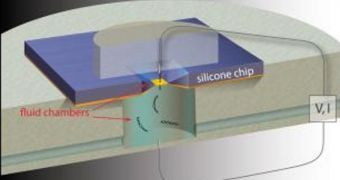Scientists at the University of Boston have recently developed a new DNA sequencing method that is touted to become a lot cheaper and faster than any current technique in a short time frame. One of the main mechanisms that the new technology employs is reducing the amount of DNA it requires in order to conduct its investigation. This also implies that the DNA amplification stage of the process, which is very expensive, time consuming and prone to errors, will no longer be required. The work was conducted by a team of BU biomedical engineers, e! Science News reports.
Details of the group's innovation have been published in the December 20 online issue of the prestigious scientific journal Nature Nanotechnology. The efforts were led by BU Associate Professor of Biomedical Engineering Amit Meller, who coordinated the development of the new method. The basic principle is to survey tiny pieces of DNA as they pass through silicon nanopores. Each of the pores is no more than four nanometers in width, and electrical fields are used to guide the genetic material's strands through them.
The team reports that sensitive electrical currents are then used to identify the precise type of each DNA molecule that passes through the pores. “The current study shows that we can detect a much smaller amount of DNA sample than previously reported. When people start to implement genome sequencing or genome profiling using nanopores, they could use our nanopore capture approach to greatly reduce the number of copies used in those measurements,” Meller reveals.
It was also made obvious in the investigations that the DNA strands that were longer tended to find the nanopore structures a lot faster than shorter strands. This is counter-intuitive, the team says, but it adds that this development only works for the best. “That's really surprising. You'd expect that if you have a longer 'spaghetti,' then finding the end would be much harder. At the same time this discovery means that the nanopore system is optimized for the detection of long DNA strands – tens of thousands basepairs, or even more,” the team leader says.
“This could dramatically speed future genomic sequencing by allowing analysis of a long DNA strand in one swipe, rather than having to assemble results from many short snippets. DNA amplification technologies limit DNA molecule length to under a thousand base pairs. Because our method avoids amplification, it not only reduces the cost, time and error rate of DNA replication techniques, but also enables the analysis of very long strands of DNA, much longer than current limitations.” Meller adds.

 14 DAY TRIAL //
14 DAY TRIAL //